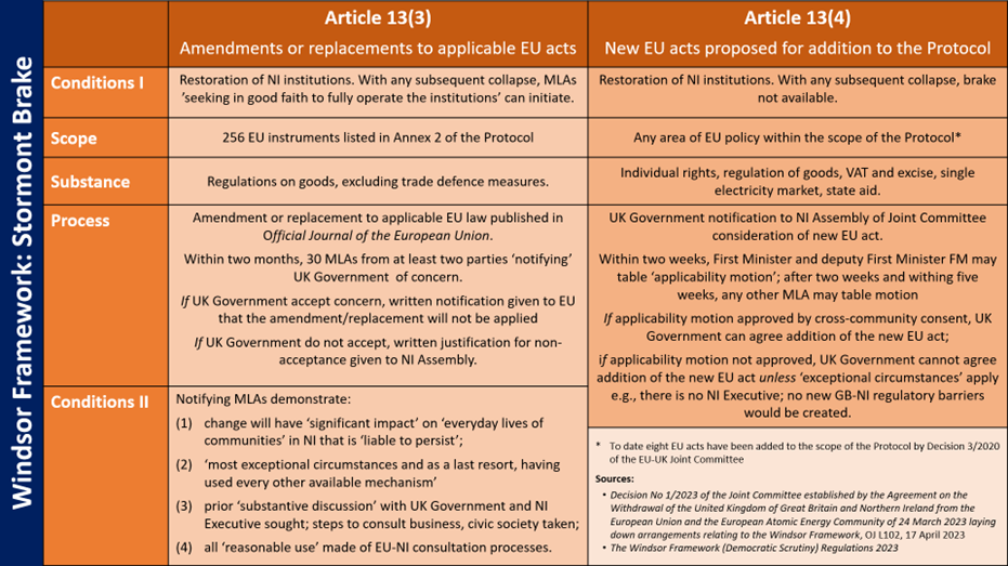Stormont Brake and Applicability Motions
An early concern about the Protocol's implementation was the lack of input from the Northern Ireland Assembly into decisions about changes in EU law that applies in Northern Ireland under the Protocol.
Under Article 13(3), amendments and replacements to EU law applicable in Northern Ireland under the Protocol apply automatically once adopted by the EU.
Under Article 13(4) the UK and the EU may agree in the Joint Committee to add relevant new EU laws to the Protocol.
EU law applicable under the Protocol therefore changes. For details of changes to date see the project's Dynamic Regulatory Alignment explainers.
So as to address, at least in part, the resulting 'democratic deficit', the EU and the UK Government agreed as part of the Windsor Framework to introduce a 'Stormont Brake' that allows members of the Northern Ireland Assembly, under certain cicumstances, to block the application of Article 13(3) amendments and replacements to EU law concerning the movement of goods applicable under the Protocol (i.e. EU acts listed in Annex 2). The provisions are contained in text added as Article 13(3a) to the Protocol.
The UK Government also agreed in domestic UK legislation to a second 'Stormont Brake' allowing MLAs to vote against the UK government agreeing to the addition of a new EU law to the scope of the Protocol via an 'Applicability Motion' process in the Northern Ireland Assembly. See also the accompanying Explanatory Memorandum.
The processes and conditions for the use of the Stormont Brake or an Applicability Motion can be summarized as follows:

Early analyses of the provisions for the Stormont Brake note the complexity of the procedures as well as the conditions involved, leading to questions as to how often it may actually be used. In principle, given the obligations that the UK has entered into in the Protocol, the Windsor Framework commitments of the UK Government and European Commission to stakeholder engagement, and to the EU taking into account issues regarding legislative changes relating to the Protocol, use of either the Stormont Brake or Applicability Motions should be limited.
Use of the Stormont Brake (Article 13(3) Protocol) can be challenged by the European Commission where it believes that the UK Government has not acted in 'good faith' (under Article 5 of the UK-EU Withdrawal Agreement) in notifying it of the non-implementation of an amendment or replacement to an EU act listed in Annex 2 of the Protocol. The matter would be referred to an arbitration panel with the UK and the EU agreeing that compliance with any ruling against the UK would be 'swift' with a recommendation that the amendment/replacement is implemented from the first day of the second month following the arbitration panel's notification.
Where the UK, in view of the Applicability Motion process, does not agree to a relevant new EU act being added to the Protocol, the EU can take 'appropriate remedial measures' (see Article 13(4) Protocol).
For more on the Stormont Brake, Applicability Motions and related processes see the 'Using the Stormont Brake' Explainer.
